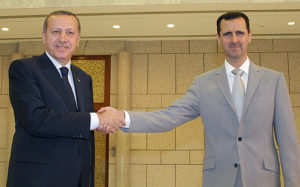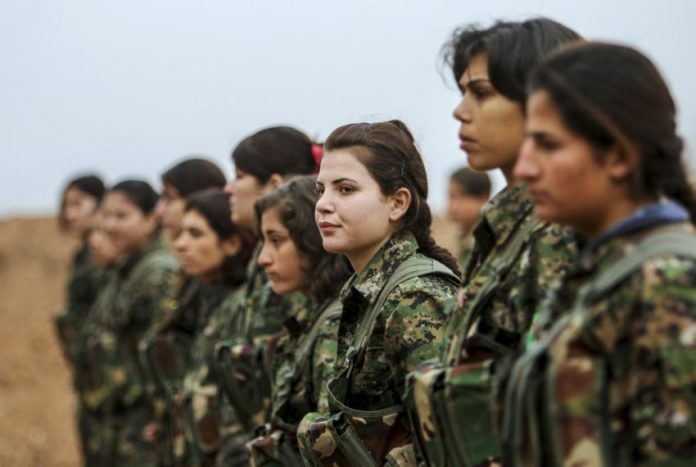US Withdrawal of Troops from Syria
Last Sunday, Trump and the Defense Secretary of the US ordered the remaining thousand American troops to withdraw from Northern Syria, leaving Kurdish forces to fight ISIS and Turkey alone.
American withdrawal from the region means that the Syrian Democratic Forces (SDF), mostly comprised of Kurdish civilians and troops, will have no allies in their fight against ISIS. It has also directly paved the way for the Turkish state to launch an offensive in Syria on October 9th, which has already caused the displacement of 1 Lakh civilians.
Trump’s own Department of Defence reportedly opposed the move to withdraw from Syria, however, to no avail. Possibly in response to all the backlash, Trump tweeted:
As I have stated strongly before, and just to reiterate, if Turkey does anything that I, in my great and unmatched wisdom, consider to be off limits, I will totally destroy and obliterate the Economy of Turkey (I’ve done before!). They must, with Europe and others, watch over…
— Donald J. Trump (@realDonaldTrump) October 7, 2019
Turkish Invasion and Syria
The Turkish attack, which has now gone on for nearly a week, is intended to drive out the SDF from the border region to create a ‘buffer zone’. The Turkish state hopes to resettle many of the 36 Lakh refugees of the Syrian Civil War in this buffer area. Denying that the US pullout had instigated the Turkish offensive, a senior US official said on Monday, “This was not caused by any action of President Trump … nothing we did was going to deter the Turks from what they wanted to do. President Erdogan was going to act regardless.”
The Turkish state considers the SDF ‘separatists’ and ‘terrorists’, despite the fact that the SDF has fought on the frontlines of the war against ISIS. The SDF is associated with the Kurdistan Worker’s Party, which has long staged an insurgency against the Turkish state.

Turkish President Erdogan has responded negatively to international diplomatic statements, which have called on him to end the conflict via negotiation with the Syrian Kurds. The Turkish President has shrugged off the criticism by saying that he will not stop the offensive, “no matter what anyone says”.
Left with no allies, the SDF has struck a deal with the Syrian government – the same entity against which it has been fighting for the past 6-7 years. The Syrian dictatorship with Bashar al-Assad at its realm used chemical weapons more than 300 times on civilians in Syria. The SDF was fighting to establish democratic rule in the Northern region, and had succeeded in carving out a small autonomous entity known as Rojava.
Rojava

Rojava is an autonomous region in the North-East of Syria, which is governed along the lines of secular, democratic, socialist, feminist and ecological ideology. It follows a ‘co-governance’ policy in which each position at each level of government in the region includes a female equivalent, of equal authority to a male. The Rojava administration guarantees freedom of speech and freedom of the press, giving rise to a vibrant media landscape.
There is a Centre For Art and Democratic Culture, which showcases work from Kurdish artists. Rojava was formally established in 2014, and within a short span of time, the administration banned child marriage, honor killings, dowry, and discrimination against women. With the withdrawal of US forces, however, it seems as though Rojava’s existence is under threat.
Assad’s troops moved into Northern Syria on Sunday night. His government is strongly backed by Russia and Iran, which drastically lowers any chance of the US returning to fight alongside the SDF. This re-forging of diplomatic ties does not bode well for Rojava.
American Department of Defense spokesperson Jonathan Hoffman stated, “The Department of Defense made clear to Turkey — as did the President — that we do not endorse a Turkish operation in Northern Syria. The U.S. Armed Forces will not support, or be involved in any such operation.” On Monday, Trump imposed economic sanctions on Turkey and called for an immediate ceasefire. He promised to send Vice President Mike Pence to Ankara as soon as possible, in order to negotiate an end to the offensive. However, with no US presence on-ground, it’s unclear as to how Trump plans to monitor or execute a ceasefire. US Secretary of Defense Mark Esper is to visit NATO next week and urge them to take collective diplomatic measures to restrain Turkey’s offensive.
The SDF has always cooperated with the US forces, including agreeing to remove fortifications in order to create a ‘buffer zone’ between Syria and Turkey. This made them more vulnerable to a Turkish attack. According to a report by the Washington Post, residents of Rojava were “stunned” at the speed at which SDF forces were collapsing. “The Americans betrayed us. We don’t trust them anymore,” said a Kurdish woman who had to flee her home near the frontlines. Meanwhile, Turkish-backed Syrian rebels have launched operations to capture strategic points of offensive from the SDF.
The medical aid and food supplies from the Rojava administration that were going to the 1.3 lakh people displaced by warfare have also been suspended. Nearly half of the aid workers from the UN have been evacuated from the area, according to an anonymous source.
Trump and Turkey
This comes to the question of why Trump made the decision to withdraw US forces in the first place. Reuters reported that it was after a phone call with Turkish President Recep Tayyip Erdogan that Trump moved forward with the withdrawal. A full transcription of the phone call is yet to be released.

In an interview with right-wing news site Breitbart in 2015, Trump said, “I have a little conflict of interest ’cause I have a major, major building in Istanbul. It’s a tremendously successful job. It’s called Trump Towers—two towers, instead of one, not the usual one, it’s two.” This so-called conflict of interest might have something to do with Trump’s decision.
It is unclear as to what Washington could gain by withdrawing its troops, particularly because American soldiers on the ground are not happy with the move. Many US troops have expressed their disappointment and frustration, stating that they are ashamed and dismayed at how the US has chosen to position itself. They also expressed concern that potential allies in future conflicts might hesitate to partner with the US, seeing the withdrawal of troops as a lack of reliability. Many diplomats around the world see the move not only as a blow to human rights but to US credibility, given that it reverses many of the gains against ISIS.
After Turkish shellfire hit Northern Syria, hundreds of ISIS supporters escaped a detention camp there. The camp, which had around 12,000 people in total, held a separate annex for about a thousand ISIS supporters – an annex that is now empty.
There seems to be no end in sight for the conflict in the region, and Trump’s actions were a concrete pathway to increased bloodshed. While Trump’s sanctions on Turkey show that he is trying to backtrack, he is, as usual, taking to Twitter to defend himself.
….I would much rather focus on our Southern Border which abuts and is part of the United States of America. And by the way, numbers are way down and the WALL is being built!
— Donald J. Trump (@realDonaldTrump) October 14, 2019
We Need to Fight for Rojava
Rojava’s autonomy, which is hard-won and precarious, can’t be destroyed now. Its destruction means more than another layer of conflict in the Middle East: it is the end of an experiment in radical democracy and inclusive self-government. In contrast to the dictatorial and authoritarian states that surround it, Rojava stood up for women’s rights, freedom of speech, and secularism. The end of Rojava means the end of the hope that a small island of peace can flourish in the midst of a sea of conflict.



